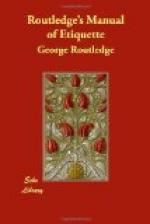Men ought to know how to carve any joint or dish set before them, or, however high their standing in the world, they appear awkward and clownish; and, therefore, all men should practise the art of carving in their youth.
The first necessary provisions for carving are the proper utensils; the most skilful of artists would be defeated in his aim if he had not his tools. The carving-knives and forks are now made specially for the various dishes. The fish-carvers, of silver or silvered metal—the touch of steel destroys the flavour of the fish—should be broad, so that the flakes be not broken in raising. For the joints of meat, a long, very sharp steel blade; and for poultry and game, a long-handled but short and pointed blade, to be inserted dexterously between the small joints of the birds. The forks must be two-pronged, and the dish must be sufficiently near to the carver to give an easy command over it.
Having the needful utensils for work, all now depends on the coolness, confidence, and dexterity of the carver, with that small knowledge of anatomy that enables him to know what joints there must be in the piece before him, and where they are situated. In butcher’s meat, one rule is almost universal: the slice cut must be cut across the fibres of the meat, and not along them; a process which renders it more easy to masticate and digest. The exceptions to this rule are the fillet or under-cut in a sirloin of beef, and the slices along the bone in a saddle of mutton. In cutting a joint of meat, the strong fork is used to steady it; but in carving poultry it is the fork which is most useful in removing the wing and leg by a jerk, without leaving any ragged remains adhering to the body. All this must be accomplished by dexterity, not by strength, and any lady may acquire the art by a little observation and practice.
A knife should never be used for pies, entrees, or sweet dishes; a spoon wherever a spoon can be used.
In helping to choice dishes, stuffings, &c., the carver should always calculate the number of the company, and proportion the delicacies discreetly.
* * * * *
FISH.
TURBOT.
There is more art in delicately carving the imperial turbot than any other fish, in order that every one may be supplied with the rich skin and fins, so highly appreciated by epicures. It is always brought to table with the white or under-side uppermost, as this is the most delicate part. The point of the fish-knife must be drawn done the middle to the bone, and from thence deep cuts made at right angles, and the squares, thus made, carefully raised, including the portion of fin attached to each. After the upper part is consumed, the back-bone may be removed, and the lower part divided in the same way, neatly, and without breaking the flakes. Brill, a fish much inferior in quality, but sometimes introduced as turbot, must be carved in the same way.




